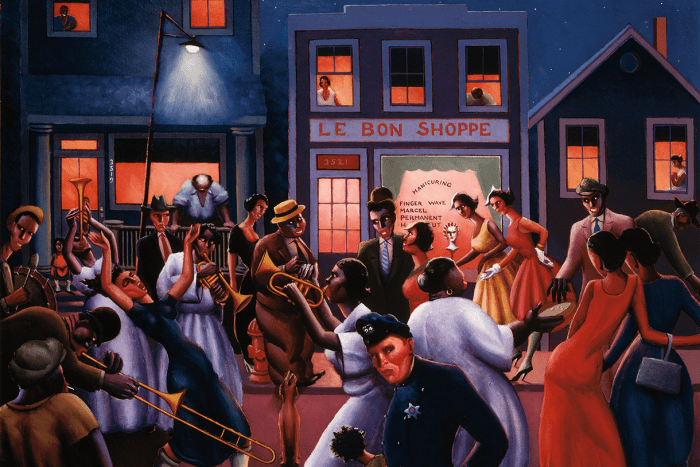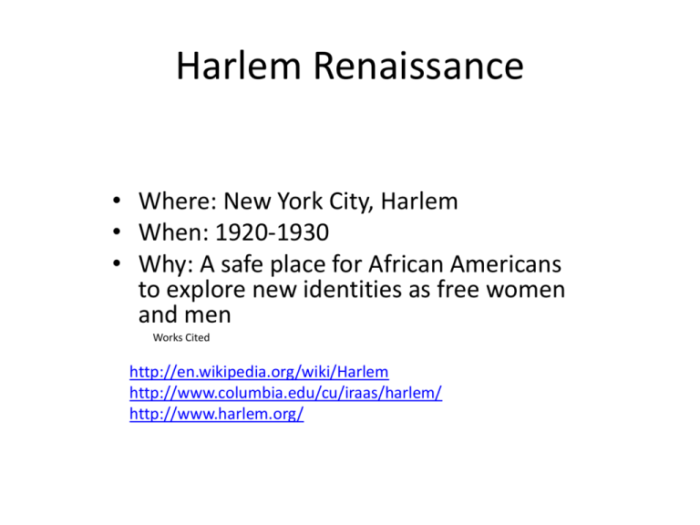Interesting facts about the harlem renaissance – The Harlem Renaissance, a vibrant cultural movement that flourished in the 1920s and 1930s, left an indelible mark on American society. Delving into the intriguing facts that shaped this era, this exploration uncovers the social, artistic, and literary forces that fueled the Harlem Renaissance, highlighting its enduring impact on American culture.
Emerging amidst the social and economic transformations of the early 20th century, the Harlem Renaissance fostered a surge of creative expression that celebrated African American identity and challenged societal norms.
Historical Context

The Harlem Renaissance was a vibrant cultural movement that flourished in the Harlem neighborhood of New York City during the 1920s and early 1930s. It was a period of unprecedented artistic and intellectual output by African Americans, who used their voices to express their experiences, aspirations, and challenges.
The Harlem Renaissance emerged as a result of a confluence of social, economic, and cultural factors. The Great Migration, which saw millions of African Americans move from the rural South to urban centers in the North, played a significant role.
This influx of new residents created a vibrant and diverse community in Harlem, which became a hub for African American culture and activism.
The economic prosperity of the 1920s also contributed to the flourishing of the Harlem Renaissance. The growth of the black middle class provided financial support for artists and intellectuals, while the rise of mass media and entertainment industries created new opportunities for African Americans to express themselves.
Key Figures
- Langston Hughes: A poet, novelist, and playwright known for his powerful and evocative depictions of African American life.
- Zora Neale Hurston: A novelist, folklorist, and anthropologist who wrote about the experiences of African Americans in the rural South.
- Duke Ellington: A jazz pianist and bandleader who composed and performed some of the most iconic jazz pieces of all time.
- Louis Armstrong: A jazz trumpeter and singer who played a pivotal role in the development of jazz.
- Jacob Lawrence: A painter known for his vibrant and socially conscious depictions of African American life.
Literary Achievements
Harlem Renaissance literature was characterized by its unique blend of realism, protest, and celebration. Harlem Renaissance writers used their work to explore the complexities of African American identity, to challenge racial stereotypes, and to celebrate the beauty and resilience of black culture.
Some of the most common themes in Harlem Renaissance literature include the search for identity, the struggle for equality, and the importance of black history and culture. Harlem Renaissance writers employed a variety of literary devices to express their ideas, including allegory, symbolism, and satire.
Musical Innovations
The Harlem Renaissance was a period of great innovation in jazz music. Jazz musicians began to experiment with new sounds and rhythms, creating a more complex and sophisticated form of music. The Harlem Renaissance also saw the emergence of new jazz subgenres, such as swing and bebop.
The influence of African American musical traditions on jazz was profound. Jazz musicians drew inspiration from spirituals, work songs, and blues, creating a unique and distinctly American sound.
Visual Arts
The Harlem Renaissance also had a significant impact on the visual arts. Harlem Renaissance artists created paintings, sculptures, and photographs that celebrated African American culture and challenged racial stereotypes.
Harlem Renaissance artists often drew inspiration from African and African American art forms. They used bright colors, bold patterns, and stylized figures to create works of art that were both beautiful and powerful.
Cultural Legacy, Interesting facts about the harlem renaissance
The Harlem Renaissance left a lasting legacy on American culture. It helped to break down racial barriers and to raise awareness of the contributions of African Americans to American society.
The Harlem Renaissance also inspired subsequent generations of artists and intellectuals. It helped to create a more inclusive and diverse American culture, and it continues to be celebrated as a major moment in American history.
User Queries: Interesting Facts About The Harlem Renaissance
What were the key factors that contributed to the Harlem Renaissance?
The Harlem Renaissance emerged from a confluence of factors, including the Great Migration of African Americans to urban centers, the rise of jazz music, and the growing awareness of racial inequality.
Who were some of the prominent figures associated with the Harlem Renaissance?
Langston Hughes, Zora Neale Hurston, Duke Ellington, and Jacob Lawrence were among the many talented artists, writers, and musicians who played a pivotal role in shaping the Harlem Renaissance.
What was the impact of the Harlem Renaissance on American culture?
The Harlem Renaissance challenged prevailing stereotypes and paved the way for greater recognition of African American contributions to American society. Its influence can be seen in subsequent generations of artists, writers, and activists.


